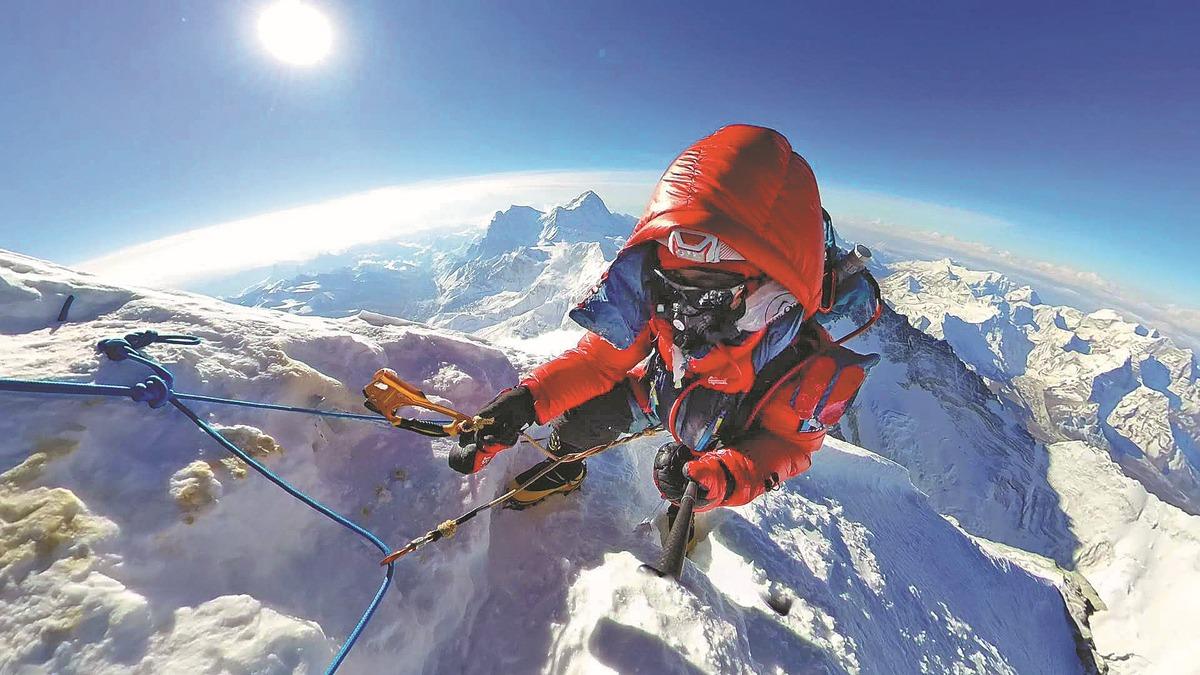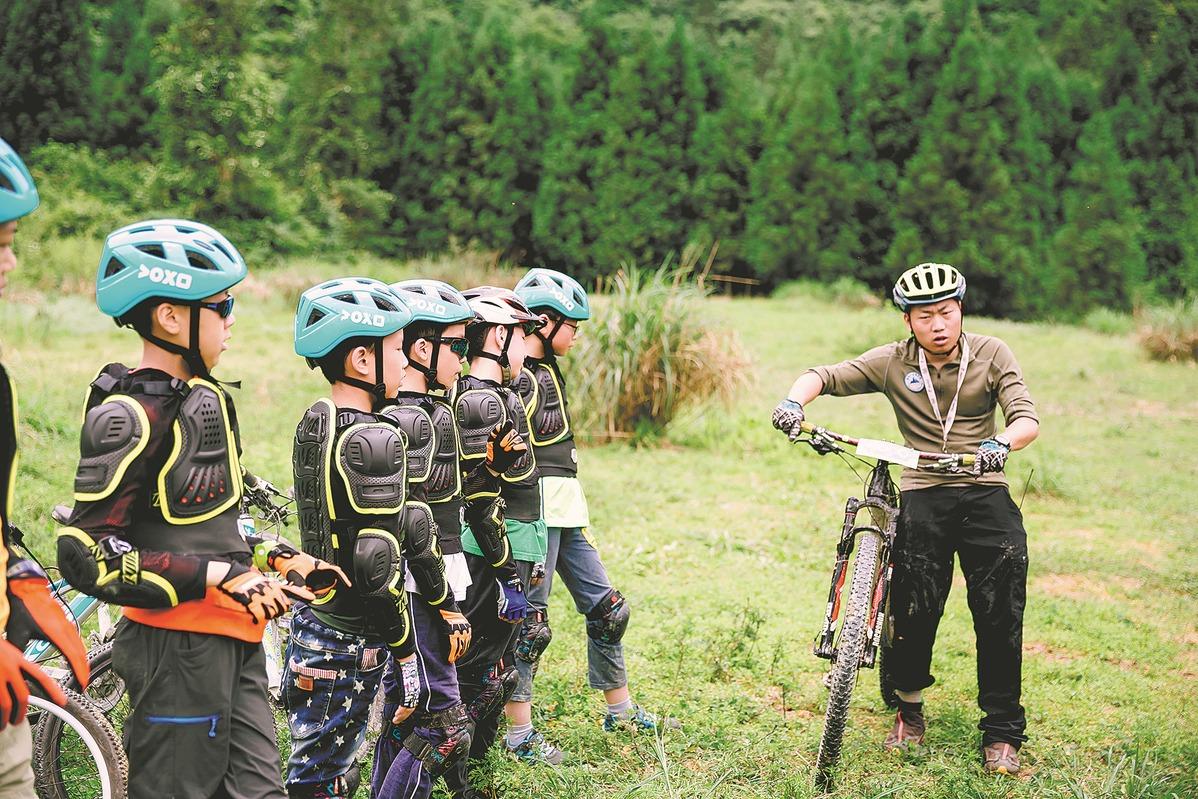 Wang Minglong, a 34-year-old man diagnosed with ankylosing spondylitis, or AS, climbs the world's tallest peak Mount Qomolangma. (PHOTO / CHINA DAILY)
Wang Minglong, a 34-year-old man diagnosed with ankylosing spondylitis, or AS, climbs the world's tallest peak Mount Qomolangma. (PHOTO / CHINA DAILY)
CHONGQING – At age 13, Wang Minglong was diagnosed with ankylosing spondylitis (AS) — a type of arthritis that causes inflammation in the joints and ligaments of the spine — and was told that he might spend the rest of his life in a wheelchair.
Some two decades later, with 18 titanium-alloy pins in his body and an inflexible spine, the 34-year-old became the first person in the world with the disease to scale the world's tallest peak Mount Qomolangma, known as Mount Everest in the West.
After years of preparations, on May 18, he finally stood on the top of the world, demonstrating the power of passion, courage and perseverance.
"The disease and pain can only make me love the world a lot more," he said. "I want to spread the passion for life to more people around me."
Wang, at just shy of 1.6 meters tall, weighed less than 50 kilograms when he returned home from the arduous climb, having lost 12 kg during the journey.
Many people forget their dreams or the power of dreams in their daily life," Wang said. "I want to enlighten their passion for life with my adventure.
Wang Minglong
As his inflexible spine severely limits his head and upper body movements, it took him much longer during the ascent and descent, and his journey was more dangerous than for other climbers.
"I was so close to death at least three times, I thought I might die up there (on the mountain)," he said.
At least 12 climbers have died and five are missing and feared dead on Qomolangma during this year's main climbing season that just ended, the deadliest period since an earthquake triggered an avalanche that killed 18 people in 2015, according to Reuters.
Because of a series of incidents during Wang's team's final ascent, Wang found himself alone without a Sherpa guide. He had only one bottle of oxygen left, despite needing three to complete the journey more safely.
According to Nepal's regulations, each climber needs to hire at least one Sherpa guide.
"Under such circumstances, most people would have chosen to quit and return, but not me," Wang said.
He adjusted the oxygen use to the lowest level which is far from adequate for climbing.
When he reached the peak, he managed to take a photo without his face gear as proof of his arrival at the top of the world.
"My brain seemed to stop functioning due to altitude sickness and I couldn't shoot any more photos or videos," he said. "My oxygen was running low, so I had no time to enjoy the view and all I thought was I needed to return to base camp safely."
Born into a farming family in Southwest China's Chongqing, Wang was always one of the shortest and skinniest kids in his class. At age 12, he felt severe pain in his back, wrist and hip. A year later, he was diagnosed with AS. Over time, it can cause vertebrae in the spine to fuse. This fusing makes the spine less flexible and can result in a hunched posture.
There is no cure for AS.
At that time, his hip joint had a serious lesion and the doctor said he might be paralyzed in half a year and would spend the rest of his life in a wheelchair.
 Left: Wang Minglong successfully reaches the summit of Mount Qomolangma. Center: Wang, the first person in the world with ankylosing spondylitis, scales Mount Qomolangma on May 18. Right: Wang, an outdoor enthusiast, rides his mountain bike in the open air. (PHOTO / CHINA DAILY)
Left: Wang Minglong successfully reaches the summit of Mount Qomolangma. Center: Wang, the first person in the world with ankylosing spondylitis, scales Mount Qomolangma on May 18. Right: Wang, an outdoor enthusiast, rides his mountain bike in the open air. (PHOTO / CHINA DAILY)
Hope ignited
The teenage boy fell into a deep depression and became suicidal due to continuous pain and desperation, that is, until he watched the movie Forrest Gump at school and was inspired. "I wanted to run like Gump and I wanted a fulfilling life as well," he recalled.
Spurred on by the movie, Wang joined the school's athletic team and started running every morning despite the pain.
After four years, to his surprise, he grew much stronger and ran faster than most of his teammates. At the same time, he performed well in his study and became a computer science major at Chongqing University, one of the top universities in China.
There he fell in love with cycling and founded the first cycling club of the university. He has cycled from Chongqing to Sanya in Hainan province (1,800 kilometers), Beijing (2,100 km) and Lhasa, Tibet autonomous region (2,800 km).
As a father of a son and a daughter, Wang established an outdoor club for young people in 2013 to help more kids get close to nature. After seven years of training and practice, he became a national-level outdoor instructor with the Chinese Mountaineering Association in 2019.
But his disease never left him. In 2021, a medical check found that his spine had several old fractures and was about to break. The doctor told him that one fall could make him a paraplegic, and suggested surgery.
The surgery was a success. As his hunched spine was straightened by 18 titanium-alloy pins, Wang was 12 centimeters taller and his lung capacity increased by 30 percent after his chest cavity was widened. After some rest, he found himself much stronger and physically more prepared to realize his dream of scaling the highest mountain in the world.
Last September, he conquered Mount Manaslu, the eighth-highest mountain in the world at 8,163 meters, in order to meet the requirement to climb Mount Qomolangma.
 Wang teaches at an outdoor club for young people he established in 2013 to help more kids get close to nature. (PHOTO / CHINA DAILY)
Wang teaches at an outdoor club for young people he established in 2013 to help more kids get close to nature. (PHOTO / CHINA DAILY)
Power of dreams
Wang's story not only inspired his young students at the club but also several hundreds of patients living with AS.
"Many people with AS have followed my WeChat account and they said they have gained a lot of courage and strength from my daily posts of outdoor activities," Wang said.
In order to engage more people in his Mount Qomolangma project, he launched a "500 dream sponsors "program to raise funds for the trip.
"Many people forget their dreams or the power of dreams in their daily life," Wang said. "I want to enlighten their passion for life with my adventure."
The trip to climb Mount Qomolangma usually costs 500,000 yuan ($70,086). The plan was that each sponsor would donate 1,000 yuan and Wang would write down their dream on a piece of card and take the 500 cards to the top of the world.
He finally won the support from 506 sponsors from all walks of life, aged from six to 103, to help him realize his own dream.
Zhang Hong, Asia's first visually impaired person to climb Mount Qomolangma, was one of his sponsors, and his dream was to scale the 14 highest mountains in the world.
For Wang, his expeditions have only just begun. In five years, he plans to complete the Explorer's Grand Slam to climb the tallest mountain on every continent and ski to the North and South Poles.
"After my kids go to college, I will take my wife to travel around the world by bike," he said.


